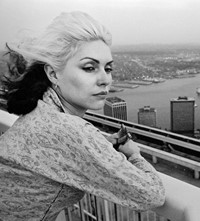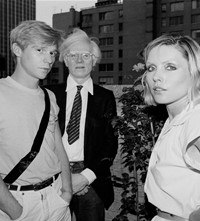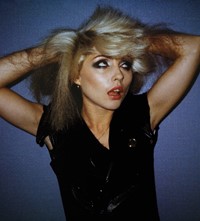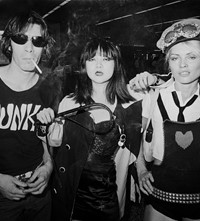Seven People Share Their Memories of Iconic New York Club CBGB
- TextSabrina Cooper
From Blondie’s Chris Stein to The B-52s’ Kate Pierson, meet the people who were part of this downtown New York City landmark on what would have been its 45th birthday
How would it be remotely possible to encapsulate the scene of legendary New York City concert venue, CBGB, in a single article? This downtown institution would have turned 45 years old today and one thing is certain: there could never possibly be another club like it again.
During its heyday in the 70s, nobody saw its future being culturally significant. After all, it was born on December 10, 1973 in a derelict part of the East Village at 315 Bowery between First and Second Streets. Hilly Kristal, its owner and father figure, envisioned a club for Country, Bluegrass and Blues (hence the acronym). Instead, it became “the undisputed birthplace of punk rock” and new wave bands like Television, Talking Heads, The Patti Smith group, The Ramones, Blondie, The B-52s, The Misfits, and The Dead Boys. Later in its lifetime, crowds would also come to see The Police, Bad Brains, Sonic Youth, The Beastie Boys, Green Day and Moby.
Mired in rent controversy, Kristal closed CBGB in 2006 with a final concert by Patti Smith. In the lead up to that time, CBGB still functioned as a place for local bands to play. Audiences have never forgotten its past nor its distinct sound system. To stand in that space was being immersed in music history.
But don’t take our word for it. Another Man spoke to the people who were there and experienced CBGB’s story: the musicians, the journalists, a photographer, and a former bartender whose memories – onstage, offstage and on the sidewalk outside – have kept it alive.
Chris Stein
Chris Stein is a writer, photographer and founding member of Blondie. In his new photography book, Point of View: Me, New York City, and the Punk Scene, he captured the city in the 70s and 80s.
“I used to live at 1st and 1st. I was in CBGB before I was working with the band [Blondie]. We walked in. Eric Emerson was onstage playing. I recently saw that Eric claimed to have helped build the first stage at CBGB. The first stage was on the left. And when it got enlarged, it was later on the right. The bathrooms used to be upstairs too. Nobody had access or dealt with downstairs. So it was configured a bit differently early on.
There were paintings and murals on the walls – horse racing – that must have gone back to the 20s. The atmosphere was pretty much unchanged: funky and bohemian. Hilly moved a lot of his personal stuff there like overstuffed armchairs and couches. In front, there was a bookshelf with books so you could sit around. He had an apartment in the neighborhood, but he also used to crash at the club, too.
There’s a picture in the new book I’m really fond of: Lester Bangs on the beach in Coney Island and he’s with one of the girls in a band called The Slander Band. He looks so uncomfortable and out of place; at the same time he looks tough and imposing. It’s a good combination.
Television had this song called Venus that we used to cover with Blondie. And The Ramones’ I Don’t Wanna Go Down to the Basement. Once The Ramones came to CBGB’s, there was a solidifying of the whole scene because they were focussed.”
Kate Pierson
Kate Pierson is a founding member and lead vocalist of the B-52s.
“It had a reputation of being the epitome of the place you’d want to play in New York City. We started in Athens (Georgia), and we didn’t have a place to play there. Our friends said you should go to New York City. We took a tape up there and played it for CBGB and Max’s. CBGB’s rejected it so we played our first gig at Max’s. Once we played at Max’s, somehow word got around. There was a little bit of buzz. We got people dancing and a bunch of our friends came up with us. Next time we tried to get into CBGB they said yes, but they said you could only play one club or the other. We were like, ‘Come on! We’re driving up from Georgia!’ So finally they relented. We started playing both clubs. CGBG was the one on the map where already Patti Smith was playing and Talking Heads, and Television.
It was intoxicating because it felt cozy. It had a great sound system. That’s what people went for. The stage was rickety. We had to crowd onto the stage. We had no road techs with us so we had to plug in our own equipment which we found challenging. The first gig we did there, we were terrified. We didn’t speak much. We moved robotically. People thought we were from England.
I have vivid memories of seeing The Ramones there and I just pogoed for an hour.”
“I have vivid memories of seeing The Ramones there and I just pogoed for an hour” – Kate Pierson
Eddie “Legs” McNeil
Eddie “Legs” McNeil is the co-founder of Punk magazine and co-author with Gillian McCain of Please Kill Me: The Uncensored Oral History of Punk. McNeil is often cited with coining the term “punk” for the music genre.
“Well, it smelled like shit. The first time I went there, it was autumn of 1975 and [John Holstrom and I] went to see The Ramones. Lou Reed was sitting there. He was eating this cheeseburger, and I wanted a bite but Lou didn’t offer us any. The Ramones came out and they started playing different songs. They threw down their guitars in disgust and they walked off stage and came back about two or three minutes later. They started playing the right song. I don’t know what song they attempted to play. But once they came back and hit it, it was like getting hit by this tidal wave. The sound was fantastic. The songs were so short and there were no guitar or drum solos.
CBGB was more like Ground Zero. We went to Max’s [Kansas City] too and sometimes you’d go back and forth to Max’s and CBGB’s a couple times a night. Everything that happened came out of CBGB. It was like central headquarters. It was like home. It was like your living room. Hilly, in the early days, would pass out on the couch at about 10. He would drink some weird drink like Fresca and vodka and he would be pretty drunk so as soon as he passed out, the inmates took over the asylum. It was a lot of fun.”

Jackie Luther
Jackie Luther is a writer, musician, and former CBGB bartender from 1993 to 2006.
“You felt like you were walking into history when you were there. It was a very old bar from like the late 1800s. There were the neon lights that were always on. There were stickers on top of stickers on top of stickers. And it smelled like old wood and dreams. It was dark, which was terrific. You just felt like you were part of something when you were there.
Visiting the club, I was enamoured of its history. Everyone in the punk rock world started there. The difference about working there was that it became home. It was my home and it became my heart.
Working for Hilly was like working for your grandpa that loved you but would yell at you from time to time. Hilly had this wonderful, innate talent for gathering people together of the same ilk. The people that worked for him were artists, musicians and writers. But there was something beautiful and fractured about us. He loved that. He liked to nurture that artistic spirit. Working for him could be exhausting because sometimes he could be curmudgeonly but he loved you. At one moment he would yell at you for leaving the orange juice out overnight, and the next moment he would be helping people with their rent disputes on the Lower East Side. He was a very giving man.”
“You felt like you were walking into history when you were there” – Jackie Luther
Rachel Felder
Rachel Felder is an author and fashion journalist who contributes to The New York Times and was a CBGB regular and close friend to Joey Ramone.
“I started going there when I was 11 years old and went through my teenage years until it closed. It was like a movie set styled to look like a no-frills bar. In between bands, you would stand on the sidewalk. There were no fancy neighbors in that era to complain about noise on the sidewalk. It was like a cocoon of community. That’s what was so special about the punk rock movement in New York in the 70s. It was an embracing community for all us misfits.
There’s a trajectory from The Ramones wearing motorcycle jackets and being so strongly linked with CBs and then everyone adopting that as the coolest clothes you could wear. CBs has become a symbol of punk rock cool and punk attitude and confident insouciance and strong attitude. That’s been adopted by so many designers. Hedi Slimane looked to that and was inspired by it. The lineage of that look starts in New York City. The bands that adopted it started at CBGB.
A lot of the original American punk bands just kind of dressed that way because that’s all they had access to. They wore ripped jeans because your jeans got ripped. You wore Converse All Stars because they were cheap and they looked good.
When I think of CBs, the song that comes to mind is Beat on the Brat. The Bowery was so rough and CBs was this oasis of wonderfulness – except for the bathroom.”

Will Hermes
Will Hermes is the author of Love Goes to Buildings on Fire: Five Years in New York City that Changed Music Forever and a contributor to The New York Times and Rolling Stone. He is currently working on a biography of Lou Reed.
“I didn’t really know much about CBGB. I lived out in Queens at the last stop on the subway. I had heard about this group, Television, from a friend. I wasn’t 18 so I knew it was a bar where there was music. You had to be 18 to get in. I figured if I dressed up, I would look older. I put on a dressy shirt, slacks and whatever constituted getting dressed up in 1976. I got there and I was ready to get the third degree at the door. The woman was like ‘Five dollars.’ I got to see Television who I thought were astonishing. I had never seen a rock band in a space that small. The fact that you could go see a band in a tiny place like that – people who lived around the corner and played as well as anybody you could hear on the radio – was mind-blowing.
It was a cruddy, dank, dark, smelly bar. All my memories of the horrific bathrooms kind of collapsed into one unified field of revulsion. You had to walk past the stage to go downstairs to get to the bathrooms.
I would love to go back and see The Ramones again because they were one of the most thrilling live bands ever. They would come out and play like 20 songs in 30 minutes. It was like – blink and you missed them.
The line ‘Broadway looked so medieval’ in the Television song Venus makes me think about CBGB, and how the scene there was a bloom growing out of ancient rubble.”
“It was probably one of the worst dives you’ve ever been to. It was a wooden, corridor shack with the worst toilets in the world. It was packed with everybody every night that was ever gonna be anybody or do anything” – Dave Vanian
Dave Vanian
Dave Vanian is the lead singer of British punk rock band, The Damned.
“It was probably one of the worst dives you’ve ever been to. It was a wooden, corridor shack with the worst toilets in the world – no privacy anywhere. It was packed with everybody every night that was ever gonna be anybody or do anything. We went over and played three nights and two sets a night. We played with the Dead Boys. We had never done two shows a night like that. It was incredibly hot and sweaty. I remember all the cool people from the bands at the time came to check out this thing from England that came over: The Damned.
I don’t think we realised it at the time but there was quite a lot of pressure on us because obviously we were the first [UK] band over there. But it was no different than any other show we would have done. We went onstage at that point having to prove ourselves. There was very much an attitude of you either like us or you don’t and we don’t particularly care.
The first night of the show – never met these guys – we got a telegram from The Rolling Stones and they sent us a dozen cream pies and free hookers. And the pies went out into the audience immediately. I think the telegram said, ‘Good luck in the USA.’ I thought that was very nice of them. Never heard from ‘em since.
Sometimes a club isn’t represented by what it is – it’s more what it becomes. Some of the most seedy, horrible places become the most amazing places to see bands.”
















